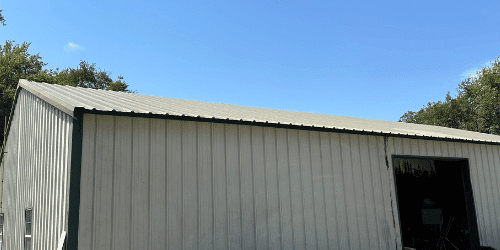Living in Allen, Texas, means embracing a mix of sunny skies, torrential downpours, and the occasional hailstorm. Your home’s roof isn’t just a layer of protection—it’s your first line of defense against these ever-changing conditions. Choosing the right roofing material isn’t just about aesthetics or affordability—it’s about making a smart, lasting investment that keeps your home safe and secure through every season. Whether you’re a homeowner looking for residential roofing services or a business in need of commercial roofing services, making the right choice can save you time, money, and stress.
Key Takeaway: Selecting the right roofing material for Texas weather is essential to ensure durability, energy efficiency, and long-term savings.
Understanding Texas Weather and Roofing Demands
Heat, Hail, and Heavy Rains
Texas is no stranger to extreme heat. Asphalt shingles can suffer under intense UV exposure, making asphalt shingle roof replacement a common necessity. Hailstorms also take their toll, especially on older or brittle roofing systems. Finally, heavy rains can lead to water damage if your roof isn’t properly sealed, leading to expensive roof leak repair.
Wind Resistance and Energy Efficiency
Roofs in Allen must be able to withstand strong wind gusts without lifting or tearing. Metal roofing, known for its wind resistance and energy efficiency, is often a wise choice. Tile and composite materials can also perform well when installed correctly, offering superior insulation to reduce cooling costs in summer.
Seasonal Shifts and Maintenance Needs
With hot summers and occasional freezes, roofing materials in Texas must accommodate thermal expansion and contraction. Metal roofs expand and contract efficiently, whereas materials like tile or asphalt may crack over time. Regular roofing maintenance programs help detect and address small issues before they grow into major concerns.
Comparing Popular Roofing Materials
Asphalt Shingles, Metal Roofing, and Tile Roofing
Asphalt shingles remain a favorite due to affordability and ease of installation. However, they may not last as long in Texas’ extreme climate. Metal roofing installation is growing in popularity for its longevity, durability, and energy efficiency. Tile roofs, while heavier and more expensive, offer beauty and long-lasting protection if installed correctly.
Flat Roof Options for Commercial Properties
Commercial buildings often feature flat roofs that require specific materials like TPO, EPDM, or modified bitumen. These systems are designed to handle standing water and provide reflective surfaces that reduce energy costs. Regular inspections are crucial for maintaining these roofs and preventing costly flat roof repair needs.
Durability and Lifespan Considerations
Longevity is a key factor when choosing roofing. Metal roofs can last 40-70 years, while tile roofs can exceed 50 years with proper care. Asphalt shingles typically last 15-30 years, making them less ideal for long-term investment unless budget constraints dictate otherwise.
Factors to Consider When Choosing a Roofing Material
Cost, Aesthetics, and Climate Compatibility
The upfront roof replacement cost often influences homeowners’ decisions. However, cost should be weighed against lifespan and maintenance needs. Aesthetic preference is also important—tile roofs offer a Mediterranean look, while metal and asphalt can mimic various styles. Compatibility with the Texas climate should always be a top priority.
Weight and Structural Integrity
Not all homes can handle the weight of a tile roof without additional structural support. Before selecting a material, it’s important to consult with experienced roofing contractors to ensure your home’s structure can support the load.
Installation and Maintenance Requirements
Different materials come with varying installation demands. Metal and tile require more skill and precision, so it’s essential to work with qualified roof replacement contractors. Long-term maintenance should also be considered—metal roofs need minimal upkeep, while shingles may require more frequent inspections.
When to Replace Your Roof
Signs of Damage and Deterioration
Common signs include curling or missing shingles, visible leaks, and sagging areas. Storm damage may also necessitate emergency roof repair, especially after hail or high winds. Keeping up with routine inspections can prevent minor issues from escalating.
Age and Material Lifespan
If your roof is nearing the end of its expected life—especially for shingle roofs—it may be time to consider roof replacement near me. Even if it’s not leaking yet, older roofs are more vulnerable to sudden failure.
Energy Inefficiency and Interior Damage
An aging roof may allow hot air to enter in summer or warm air to escape in winter, leading to increased energy bills. Water stains on ceilings or mold in the attic are also signs it’s time to contact experts for an evaluation and potential roof replacement estimates.
Financing Your New Roof
Budgeting and Exploring Affordable Solutions
Replacing a roof is a major investment, but there are affordable roofing solutions available. Some companies offer roof replacement financing options to help spread out payments over time.
Insurance and Storm Damage Claims
In cases of storm damage, your homeowner’s insurance may cover part or all of your replacement. Having thorough documentation and working with a reputable contractor who understands the claims process can make a huge difference.
Value and Return on Investment
A new roof boosts property value and provides peace of mind. Whether you’re planning to stay for decades or sell soon, it’s a smart investment in your home’s future.
Answering Common Questions
What is the best roofing material for hot Texas summers?
Metal roofing is one of the best options because it reflects sunlight and resists UV damage, reducing cooling costs.
How often should I have my roof inspected?
It’s recommended to schedule roofing inspection services at least once a year and after major storms to catch problems early.
Can I finance a full roof replacement?
Yes, many reputable companies offer roof replacement financing to help homeowners manage costs without delay.







